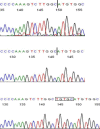Exome capture and massively parallel sequencing identifies a novel HPSE2 mutation in a Saudi Arabian child with Ochoa (urofacial) syndrome
- PMID: 21450525
- PMCID: PMC3157539
- DOI: 10.1016/j.jpurol.2011.02.034
Exome capture and massively parallel sequencing identifies a novel HPSE2 mutation in a Saudi Arabian child with Ochoa (urofacial) syndrome
Abstract
We describe a child of Middle Eastern descent by first-cousin coupling with idiopathic neurogenic bladder and high-grade vesicoureteral reflux at 1 year of age, whose characteristic facial grimace led to the diagnosis of Ochoa (urofacial) syndrome at age 5 years. We used homozygosity mapping, exome capture and paired-end sequencing to identify the disease causing mutation in the proband. We reviewed the literature with respect to the urologic manifestations of Ochoa syndrome. A large region of marker homozygosity was observed at 10q24, consistent with known autosomal recessive inheritance, family consanguinity and previous genetic mapping in other families with Ochoa syndrome. A homozygous mutation was identified in the proband in HPSE2: c.1374_1378delTGTGC, a deletion of 5 nucleotides in exon 10 that is predicted to lead to a frameshift followed by replacement of 132 C-terminal amino acids with 153 novel amino acids (p.Ala458Alafsdel132ins153). This mutation is novel relative to very recently published mutations in HPSE2 in other families. Early intervention and recognition of Ochoa syndrome with control of risk factors and close surveillance will decrease complications and renal failure.
Copyright © 2011 Journal of Pediatric Urology Company. Published by Elsevier Ltd. All rights reserved.
Figures




References
-
- Stein EA, Stein DE. Rectal procidentia: diagnosis and management. Gastrointest Endosc Clin N Am. 2006;16:189–201. - PubMed
-
- Mack KJ, Johnson JN, Rowe PC. Orthostatic intolerance and the headache patient. Semin Ped Neurol. 2010;17:109–116. - PubMed
-
- Hildebrandt F, Heeringa SF, Rüschendorf F, Attanasio M, Nürnberg G, Becker C, Seelow D, Huebner N, Chernin G, Vlangos CN, Zhou W, O'Toole JF, Hoskins BE, Wolf MT, Hinkes BG, Chaib H, Ashraf S, Schoeb DS, Ovunc B, Allen SJ, Vega-Warner V, Wise E, Harville HM, Lyons RH, Washburn J, Macdonald J, Nürnberg P, Otto EA. A systematic approach to mapping recessive disease genes in individuals from outbred populations. PlosGenetics. 2009;5(1):e1000353. PMID: 19165332. - PMC - PubMed
Publication types
MeSH terms
Substances
Supplementary concepts
Grants and funding
LinkOut - more resources
Full Text Sources
Medical

